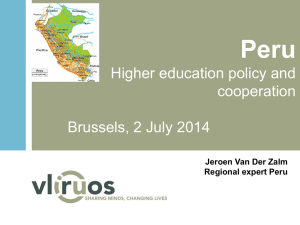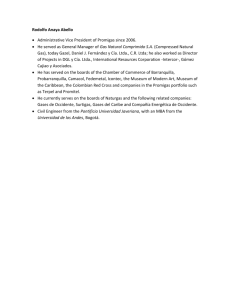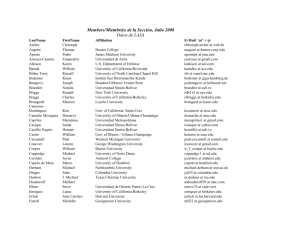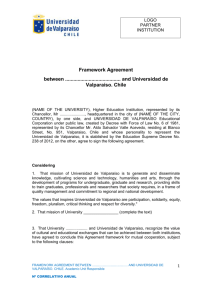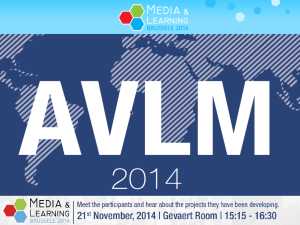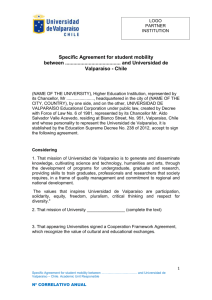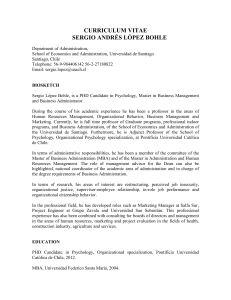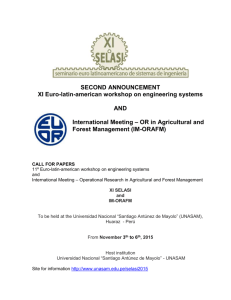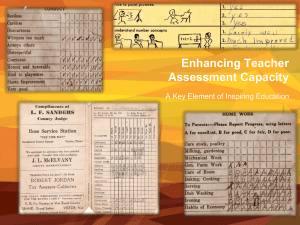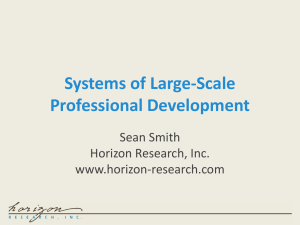pre service banff
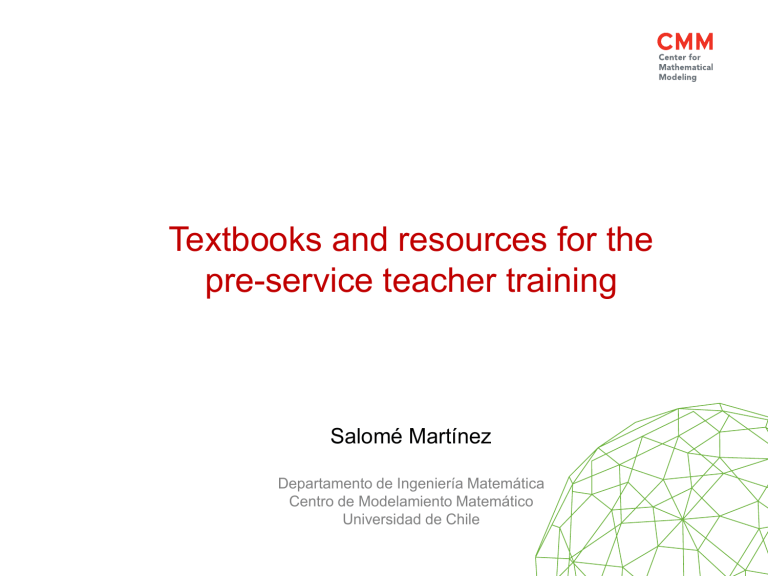
Textbooks and resources for the pre-service teacher training
Salomé Martínez
Departamento de Ingeniería Matemática
Centro de Modelamiento Matemático
Universidad de Chile
Fondef ReFIP Project
•
Fondef ReFIP “Resources for the initial training of elementary school teachers in mathematics” March 2011-April 2014
•
R&D project financed by Conicyt, with public and private partners (Ministry of Education,
Chilean Academy of Sciences, Fundación Luksic, Ediciones SM)
•
The goal is to develop materials for pre service elementary school teacher training.
•
Main “product”: Math textbooks (Numbers, Geometry, Algebra, Data and randomness)
•
Interactives (7) done in collaboration with LITE, UNAM. Collaboration with José Luis Abreu, due to our previous meeting!!
•
Teaching resources for math educators, complementing the books.
•
The project gave the opportunity to do math education research.
Math courses for elementary school teachers
•
Teacher training is quite diverse. Each institution has its own program.
•
In the last years there have been efforts to improve initial training (standards, new resources for universities).
•
The focus is on general pedagogy courses.
•
We have the feeling that number of disciplinary courses has increased in the last years.
But…
In 2007 aprox. 20% of the courses for teachers were disciplinary (spanish, math, science, social sciences) (without specialization).
Now, is 25% (aprox. 1 more course)
Math courses increased from 2 to 2 ½.
Institutions now offer specializations, but teachers can teach everything. There are institutions that offer no math classes unless your “major” is math.
Who teaches math and math didactics courses to preservice elementary school teachers?
•
It depends on the institutions: math educators, high school teachers, elementary school teachers, mathematicians.
•
In most cases there is no appointment of the lecturer in the university (just hired for the course).
Math books for teachers in spanish
•
Books available are mostly math didactics spanish books. Mathematics in them is quite abstract. A large difference between how the concepts are learned by teachers and how they are taught, for instance: to define multiplication first they define the cartesian product between two sets, fractions as equivalent classes, etc…
•
We didn’t found reasonable math books being used, mostly notes from lecturer, which were usually common math.
Math and math didactics courses for teachers
•
How are the courses for teachers?
• type of instruction?, type of content addressed at math lessons?
•
During the project we had the oportunity to observe math and math methodology classes
(initial training) (Chandía, Reyes, Martínez 2013)
•
7 teacher educators of different profiles, 3 classes.
•
For coding the class was divided in 7 moments
•
The classes were centered in common math content, no connection with classroom (89%)
•
Direct instruction (82%)
•
Problem solving (routine) (12%)
•
Little differences between math and math didactics, and between different profiles.
Opportunities for improvement
There is ageement regarding the need of improvement, and many institutions are making significant change s to their programs.
Since the last 5 years there have been several initiatives to improve initial teacher training
•
INICIA PROGRAM
Development of standards for initial teacher preparation
INICIA Diagnostic Evaluation. It is not mandatory!
•
Beca Vocación de Profesor , a fellowship to attract better students to the teaching profession
(since 2010)
•
Convenios de Desempeño en Formación de Profesores , Mineduc grant to finance universities that prepare teachers (through a 3 year grant). The goal is to promote significant strategical changes
(7 institutions 2012+4 institutions 2013).
How can we contribute?
Developing resources that can help improve the courses for future teachers which should:
Address the needs of the teachers (MKT), curriculum demands…
Take into consideration the professionals that train teachers
Take into consideration the reality of the country. For instance: (lack) knowledge they have from elementary and high school, math anxiety…
TEXTBOOKS
Textbooks (2 of them already in press, 2 next week)
Team
•
The team that produced the first drafts: 6 math educators and 8 mathematicians from 7 institutions.
•
There was teams working in each textbook, but the content was discussed by the whole team.
•
Nobody was a “specialist”. Everybody could question some part of the book, or make suggestions. This was common practice in all our previous work.
•
The final version of the books were produced by a smaller team of mostly mathematicians.
Development of the textbooks
Contents are organized according to the standards
During the first and second year we had frequent plenary meetings.
At the beginning of the project we have a workshop with S. Beckmann.
Our drafts were evaluated quite early
Permanent revision by other members of the team. Good ideas of one team were adopted by others
During the first stage, we had workshops with in service teachers, teacher educators and students
Testing of preliminary versions of each book
Final versions adjusted according to pilot expericiences (used in 16 universities during
2012, more that 100 sections)
Evaluation of contents (2013)
Production of the final textbooks lasted around 9 months, was done by small team
Math knowledge for teaching and the textbooks
•
Focused on the specialized math knowledge
•
Contents are mainly those of school curriculum
•
To show the deepness of school mathematics
•
To promote math reasoning
•
Promote thinking about mathematics, and its teaching, posing questions
•
Use of representations and models, different ways of justifying and proving
•
Illustrative examples
•
To study certain topics several times (example properties of the operations)
•
Applications of mathematics, contextualize math concepts, promote problem solving
•
Use of manipulatives (concrete-pictorical-symbolical)
•
To show that mathematics is coherent
Preliminary version (pilot)
•
The books focused in specialized math knowledge
•
Also included other aspects such as lesson planning, assessment, curriculum, misconceptions, etc
•
Included “ready to use” lesson plans (something that was requested by teachers)
•
By many this was the opportunity to “solve” many problems at once
•
Constructed by a large team, sum of different contributions, lack a thread. Also a lot of repetition (which was good to use them in courses)
•
Math reflection (Para pensar)
•
Focus on curriculum content, but there were some advanced math contents
PILOTS
First semester 2012
• 13 Universities
• 56 Courses
• 2300 students
• 40 math educators
Second semester
2012
• 15 Universities
• 75 Courses
• 2700 students
• 40 math educators
Universities
•
Pontificia Universidad Católica de Chile
(sedes Santiago y Villarrica)
•
Universidad Católica de la Santísima
Concepción
•
Universidad de Concepción
•
(sedes Concepción y Los Ángeles)
•
Universidad de Magallanes
Universidad de Playa Ancha
(sede San Felipe)
•
Universidad de las Américas (sedes Santiago y Viña del Mar)
•
Universidad del Bío-Bío
•
Universidad del Desarrollo
•
Universidad Diego Portales
•
Universidad San Sebastián (sedes Santiago,
Concepción, Valdivia, Puerto Montt)
•
Universidad Santo Tomás
•
Universidad Alberto Hurtado
•
Universidad de Viña del Mar
•
Universidad Católica de Temuco
•
Universidad Arturo Prat
•
Universidad de los Andes
Good regional coverage
Different types of universities
(selective-non selective, traditional-
non traditional, public-private)
Different types of teacher educators
Around 4000 students participated,
20000 total enrollment in Chile.
User experiences and evaluations
We received a lot of suggestions and opinions from about 15 evaluators and the 50 lecturers that used the book during the piloting stage (including some authors):
•
The books were useful but chaotic
•
So many different components made them lose focus
•
They were uneven
•
Many parts were never used
•
Not all book were used with the same intensity (Algebra and Datos y Azar)
Final books
•
We cut several parts
•
We decided not to include lesson planning, assessment.
•
We kept common errors, difficulties, misconceptions. Some of them were regarding elementary school pupils, some regarding the students.
•
We also include use manipulatives
•
Many excercises, of different type.
•
We also kept the most relevant math content
•
In many parts we focused on applications (functions)
•
Decisions on final content was made by a smaller team
•
The final version was produced considering several opinions, but it was not merely an answer to that.
Un niño pregunta: “si 0,4·0,4=0,16 ¿por qué 0,4·0,2 no es
0,8?”. ¿Qué le respondería al niño? ¿Qué ejercicio le sugeriría para que se diera cuenta de su error?
Instruments
Students
Teacher educators
• Math knowledge Tests (developed in LMT project,
University of Michigan)
• Initial survey (training, courses, preferences,
• Math attitudes and beliefs (TEDS-M), Teacher
Expectations y Math Anxiety
• Survey regarding use of the books
• Teacher journal to record the use of the book
• Survey regarding use of the book
• Interviews (1er semestre)
• Classroom observation
• Focus group
2. Sesgos en expectativas
Math anxiety and teacher expectations
•
No significant effects on the formation of opinion on personal characteristics of students.
•
There are significant effects of the sex of the student and future teacher math anxiety in the formation of academic expectations. Men received better academic expectations than females, and future teachers with math anxiety have lower academic expectations.
•
There is a significant effect of math anxiety of the future teacher in the allocation of support measures in special class.
New projects related to preservice teacher training (elementary school teachers)
•
FONDEF IT13I10005 “Resources for pre service training of elementary school teachers based on classroom experiences” (2014-2016):
Case development for training of teachers based on classroom math activities, including examples of student work, teacher-student interactions…
Development of a case study based workshop for teacher educators, including different aspects that are relevant for teacher training.
•
Professional development program (Diploma in math education) for teacher educators (starting January 2014).
